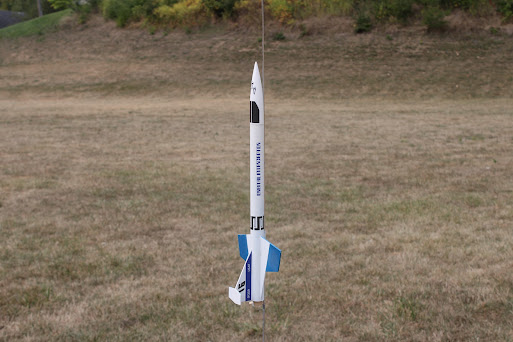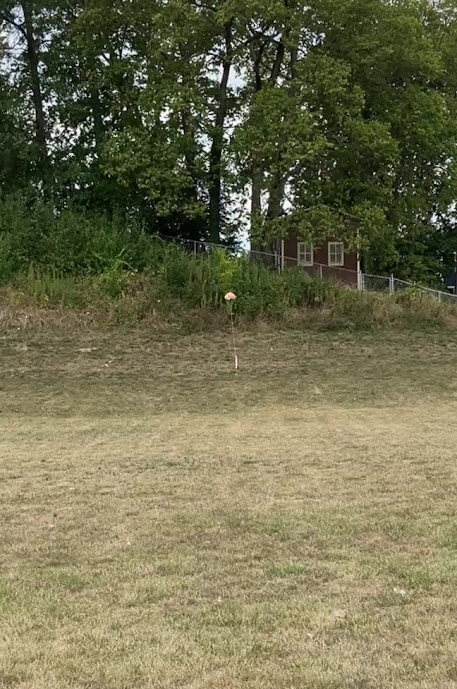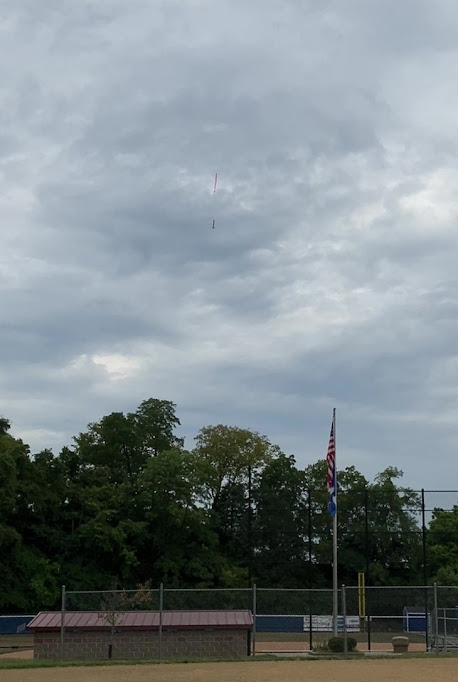In all honesty, this launch took place over two days, with one flight on Sunday and seven on Thursday. I'd missed the WSR launch on Saturday due to allergies and not wanting to drive I-75, so I attempted to do a launch on Sunday after breakfast. I had igniter issues at a previous B6-4 Field launch, so I took a bunch of igniters and painted them with a particularly trashy nail polish that was heavy on nitrocellulose. When that batch had dried, I made another batch with nail polish and a quick dip in some muzzle loaders BP. Even though I took both batches with me to the field, I only tried the nail polish igniters. Pool fever, I guess.
Things started out looking great. The wind test bird for the day would be an Estes Yellow Star Crayon that I picked up on clearance years ago. It had flown once back in 2013 and that glaring decade long hiatus ate at me every time I made a list of rockets that hadn't flown in a while. Eleven years after flight #1, flight #2 would be on a perfect day at B6-4 Field on a B6-4.
As you can see, this was a difficult build. I had to unpackage it, load it with dog barf and fluff the chute. It's actually the perfect bird for days like this. You can't overfly the field with a B6-4, and even a C6-5 would likely be doable in calm conditions. Today could have been a C6-5 day, but why push it? There was no lag on this flight. It left the pad as I pressed the button and during the flight you can hear me say "It's gonna be a good day." Not to spoil the story, but it wasn't. I was set up on the infield at deep short and the Yellow Star Crayon left the pad heading toward left field, right into the sun. It topped out at 294' and began drifting toward foul territory on the unreefed chute, touching down on the sidewalk in front of my car. I recovered it and headed back to the pad where I tried the Estes Orbital Interceptor and Comet, neither of which left the pad. By this time, I was hot, and the pool was calling loudly, so I disgustedly called it a day.
Flight #2 didn't happen until Thursday, day #2 of my August stay-cation. I chose the Estes Orbital Interceptor because it had made it to the pad before failing on Sunday. Plus, it's a sharp looking bird.
This would be an A8-3 flight as I've found that BT-50 birds are flyable on B6-4s only in conditions of extreme calm. This flight would show just why. The OI left the pad heading dead straight and topped out at 362'. It was still moving up at ejection, so something was likely left on the table altitude-wise. It drifted out toward dead center under chute and landed with a bounce but survived without damage. (August grass in NKY is concrete dry.) Once again, it looked like it was going to be a good day.
I had noticed a teacher and her class at the front of the school before the OI flight, but I didn't think they were paying attention. They were walking behind the cars in the school driveway for the OI flight and didn't seem to have noticed it, but they stopped at the end of the driveway as I was prepping the FRW Scythe for the next flight. I could hear the teacher talking to them and it wasn't until they started doing a countdown that I realized their attention had shifted to me. I waved and they cheered, so I doubled down on prepping the Scythe. This would be another A8-3 flight and once I got it ready to launch, I pointed to the students, who dutifully began another countdown. There will be no on-pad glamour shot of the Scythe because I forgot in all the excitement. You'll just have to let the video speak to your rocketry soul.
There was a slight lag from when they hit zero on the countdown to when the Scythe took off, but it was short enough to be barely noticeable. I was just glad it fired at all. This flight was also fairly straight with a slight bend to right center, topping out at 379'. At ejection the shroud lines tangled and caused a fast parawad descent to a landing in short right field. I had noticed something coming down at roughly the same rate as the rocket body, but figured it was wadding. Wrong. The nose cone had blown loose during the flight and recovered within inches of the rest of the rocket. I was a little too quick in ending the video and it caused me to cut out the standing ovation I received. Definitely a high point in my 47-year B6-4 Field career.
I recently finished applying the CMR decals to an Estes X-16 that I got in an eBay lot of badly used rockets several years ago. It needed new fins, recovery system and general shoring up and I recently got interested in finishing the project. For a rocket that was a step away from the dumpster, it turned out pretty nice. It had flown since it was painted, but this would be the first flight in full livery.
Whatever I did, I must have done it right. The A8-3 flight boosted dead straight off the pad to 263' and ejected as it reached apogee. Recovery was the best on the day with no parawad and a mostly straight drop on a nice, slow recovery in right field. Gotta admit, I was feeling good about my chances for finishing off the box at this rate.
The first hiccup of the day came next. I had a Centuri Viking loaded with an A8-3 and nothing I could do convinced it to attempt a flight. I almost packed up right then, but decided to give the recently repaired Semroc Sky Hook II a shot.
This would also be an A8-3 flight. It boosted straight to 238', then leaned left before ejection. The recovery path was S-shaped, heading back to the right before returning to center field straight out from the pad.
The Quest Antari would be the sixth flight of the day. This is a mystery bird. I have no memory of buying it, but it's possible that it was sent to be by Quest for some help I provided with a quality control issue. To date it's flown once back in 2013.
This would easily be the highest flight on the day, topping out at 406'. The Bo-Mar Spartan may have given it a run for the money if it had a normal flight, but more on that in a minute. The Antari flight was to the right off the pad and it was still heading up at ejection. Streamer was a Mylar packing strip from the batch that chaffed the inside of my car a couple of weeks back, but the lack of sun made it almost useless from a visibility standpoint. Recovery was a hard shot to the infield between first and second.
Next would be the bad-luck Bo-Mar Spartan, a clone that I best-guessed back in 2018. This would be flight #2 for this bird, with the first flight having the distinction of being the weirdest recovery of all of my 2000+ flights. The nose cone had rebounded into the top of the body tube and stuck there, resulting in a crushed tube and a nose cone scarred with a semi-circular cut. I started to fix the nose cone, but only got as far as filling and sanding to cut, so the scar is still visible.
This flight seemed normal from the start, but things quickly changed for the worse. I first thought it was an early ejection, but then noticed that the nose cone was taking an entirely different recovery path than the body tube. The nose cone hit the ground in right field, while the body tube landed in dead center. I initially suspected a snapped Kevlar shock cord, but when I found the nose cone it still had the thrust ring attached. The ring was almost completely burned away. I've never heard of an A8-3 CATO, but all things point that way.
It wasn't planned that way, but the Estes JBR-013 would be the last flight of the day. At this point in the day, I'd drawn a spectator, a neighbor who spotted me launching and wondered if I was doing what I looked like I was doing. When he first came down to the field, I thought I might be about to be asked to leave, but when he asked if I was flying Estes rockets, I figured he was one of us. He'd flown in the 70's but hadn't had anything to do with flying since then. He was wondering if the rockets I was flying were all kits or just scratch builds and I told him I had a mix of both. The JBR-013 was closest to the top of the box, so it got the nod as demonstration flight.
By this time, I was afraid I was about to run out of battery power, so it was a nice surprise when the JBR-013 actually launched. The flight was straight to 204' and ejected as it was still moving forward at ejection. I immediately realized that I'd made a mistake in not checking the chute before the flight as at ejection it remained unfurled. I explained what "parawad" meant and why it was my fault. The JBR-013 recovered to the right of the pad by 20' and the impact with the field was pretty harsh, but the fact that it hit grass helped prevent any damage other than a bit of rash at the top of the body tube.
My guest and I chatted a bit more while I prepped the Estes Comet, which was to be my next flight. He mentioned something about scouring for kits online and possibly joining me for a future launch now that he knew it was apparently legal in the Fort. He was leaving the field as I counted down to disappointment. It was a no-go, which earned me a rueful laugh from him. As he was driving away, I began prepping the Estes Astron Mark, but that too failed to launch. I considered eight flights enough for a blog update, so I packed the box, struck the pad and headed for home.



































Great flight report! Nice set of birds there.
ReplyDeleteI occasionally have to explain to myself what a 'parawad' is, though I claim no responsibility for them!
Plenty of color. Kind of like picking vegetables.
DeleteI very well may be the parawad master. Usually a cold weather phenomenon, but I transcend typical weather patterns.